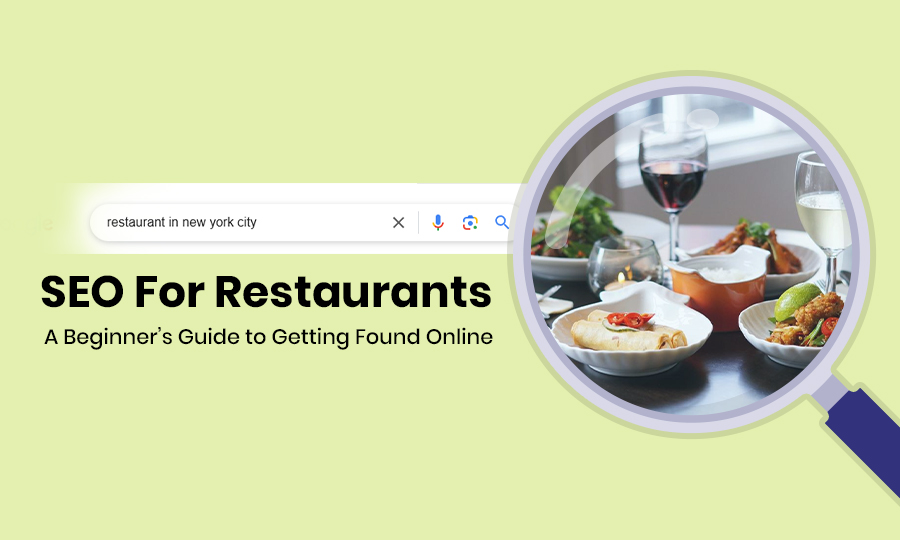Every business in today’s digital world needs a strong online presence. SEO for Restaurants is no exception.
The success of your restaurant depends heavily on effective SEO (Search Engine Optimization) strategy because search engines like Google and other search engines are now the main tools millions use to find new dining spots.
This guide shows you step by step how to boost your restaurant’s internet visibility with SEO techniques.
Understanding Search Engines and Restaurant Visibility
Understanding how search engines work is crucial for restaurant owners who want to improve their online visibility. Search engines like Google, Bing, and Yahoo use complex algorithms to rank websites based on relevance, authority, and user experience. When a user searches for a restaurant or cuisine, the search engine’s algorithm analyzes the website’s content, structure, and online presence to determine its relevance and authority.
Restaurant visibility refers to how easily customers can find a restaurant’s website, social media, and online ordering platforms. A strong online presence is essential for restaurants to attract new customers, increase website traffic, and drive online orders. By optimizing their website and online presence for search engines, restaurants can improve their visibility, increase their search rankings, and attract more local customers.
Setting Up Your Restaurant’s Online Presence
Setting up a strong online presence is critical for restaurants to attract new customers and increase website traffic. Here are some essential steps to set up your restaurant’s online presence:
- Claim your Google Business Profile: Claiming your Google Business Profile is the first step to establishing your restaurant’s online presence. This profile will help you manage your restaurant’s listing on Google Maps and Google Search.
- Create a restaurant website: A website is essential for restaurants to showcase their menu, services, and online ordering options. Make sure your website is mobile-friendly, easy to navigate, and optimized for search engines.
- Set up social media accounts: Social media platforms like Facebook, Instagram, and Twitter can help you engage with customers, promote your restaurant, and increase online visibility.
- List your restaurant on review sites: Review sites like Yelp, TripAdvisor, and Google Reviews can help you attract new customers and improve your online reputation.
What is SEO for Restaurants
The optimization of SEO for restaurants leads to better placement on search result pages through a process called SEO for restaurants.
Your ultimate objective should be to guide online users toward your restaurant after they search. By optimizing for relevant local searches, restaurants can ensure they are easily found by potential customers in their local area.
The terms can be like:
- “best Italian restaurant near me”
- “sushi restaurant in [city name].”
The optimization of both restaurant website content and unified listings on Google My Business and Yelp with additional platforms enables you to reach target customers whenever they search.
Why SEO Matters for Restaurants
Frequent eaters begin their dining search on Google or similar search services to find places.
Your restaurant’s visibility and potential new customer acquisition will grow when your search rankings enhance visibility in relevant local searches, ensuring you are easily found by potential customers in your local area.
Some key reasons why SEO matters for restaurants include:
- Increased Visibility: Your restaurant appears in front of more potential customers when it appears at the top of search results pages.
- Targeted Traffic: SEO directs your business toward customers actively searching for your products or services.
- Improved Credibility: High search results positions demonstrate both popularity and trustworthiness in the industry which draws potential customers to your business.
- Local Search: Since many restaurant searches occur in specific geographical areas local SEO serves to make your business visible to those customers near you.
Understanding these reasons is important to implement SEO for restaurants.
Key SEO Elements for Restaurants
After understanding SEO’s vital importance let us examine the essential components that influence restaurant SEO progress.
- Keyword Research
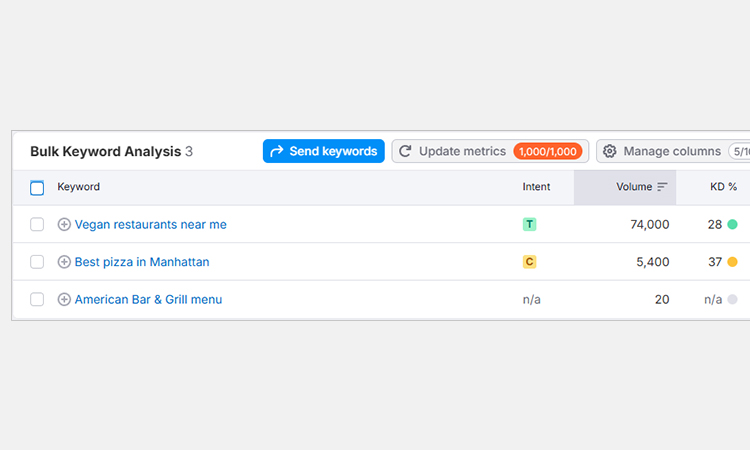
Any SEO plan begins with keyword research as its starting point.
The terms that people use to search for restaurants of your type represent essential knowledge for your business.
Keywords used for restaurant SEO should incorporate details about cuisine type together with locations and individual offerings of your establishment.
Some common restaurant-related keywords might include:
- “Best pizza in [City]”
- “Vegan restaurants near me”
- “[Restaurant Name] menu”
- “Romantic dinner spots in [Area]”
Tips for Keyword Research:
- Google Keyword Planner and Ubersuggest function as tools that help detect popular search terms.
- Think about the questions people ask when searching for restaurants. People popularly search between “What are the best restaurants in [city]” and “Where can I get pizza delivered?”
- Searches with longer keyword phrases known as long-tail keywords deliver less competition for placement.
- On-Page SEO
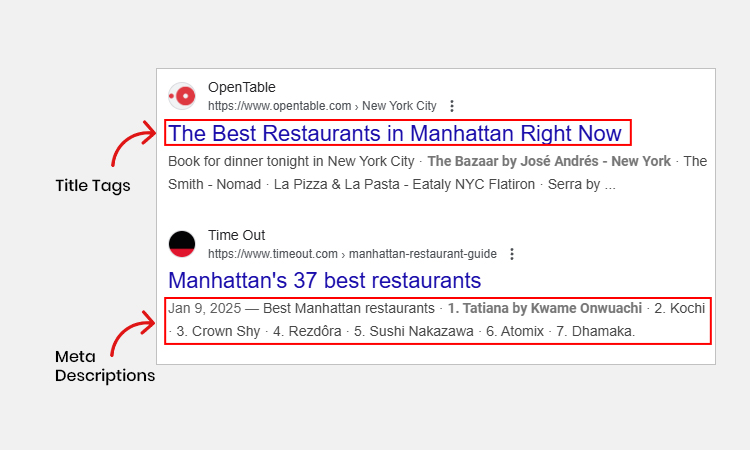
Your website’s content and HTML elements function as fundamentals in Search Engine understanding of page content that appear as On-page SEO factors.
Here are some important factors for restaurant websites:
- Title Tags & Meta Descriptions: All these elements show up in search results and users must find the target keywords within them. Such content must both inform readers about your website and provide intriguing information that leads to click interaction.
- Headings (H1, H2, etc.): Your page content benefits from structured headings which allow users and search engines to better understand site navigation. Do not forget to place your essential keyword within the H1 heading.
- Website Content: Integrate your target keywords into all your website content ranging from menus to about info to your blog digest to your other content types without over-stuffing keywords. Web pages benefit from natural use of keywords instead of using keyword repetition excessively.
- Images & Alt Text: High-quality food images need to be added to your site with relevant keyword contents in your alt text descriptions. An image with proper SEO attributes leads to better visibility in search engine image results.
- Local SEO and Local Search Rankings
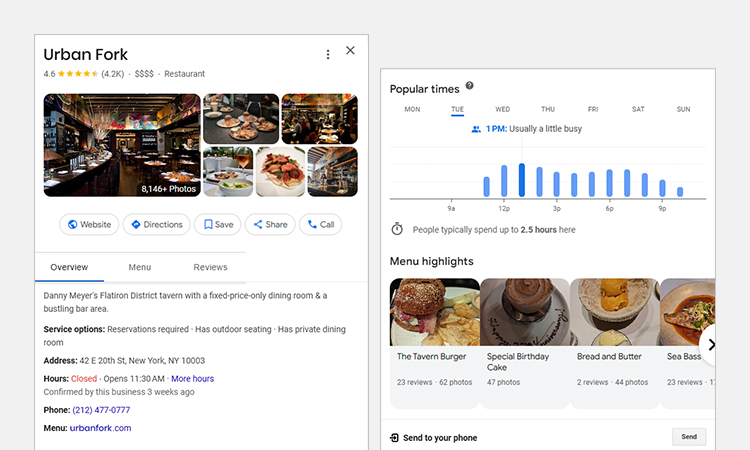
For restaurants, local SEO is absolutely essential. This is because most people search for food places near them. Local SEO helps restaurants appear in relevant local searches, making it easier for potential customers to find them.
It helps your restaurant rank for searches in your specific location.
Local SEO Best Practices
- Google My Business (GMB): You should create and optimize your Google My Business profile. You should maintain full precision of all data including your location details and contact information and operating hours and business type.
- NAP Consistency: Your Name Address Phone Number (NAP) information needs to match the same across every online directory including Google Yelp TripAdvisor etc. Unstable Name Address Phone Number (NAP) details create confusion for search engines which negatively impacts your ranking performance.
- Local Citations: Your restaurant should be listed through local directory platforms including Yelp, TripAdvisor and the Yellow Pages. When you establish your business on multiple local directories it generates greater local authority which establishes your restaurant as a trusted local facility.
- Customer Reviews: Your business should motivate satisfied customers to write feedback on Google and Yelp along with other review websites. When customers read positive reviews your online presence receives an increase in both search engine rankings and customer volume. Engage with customer reviews by responding to both good and bad feedback because you care about hearing from your customers.
- Mobile Optimization
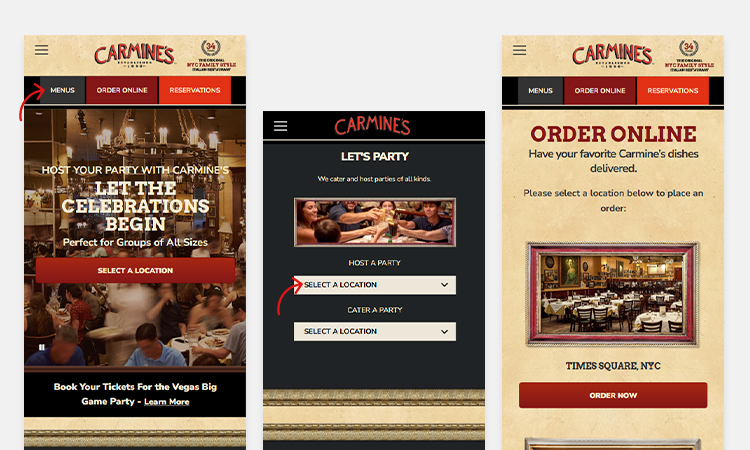
Mobile-friendly websites have become essential because restaurant searches keep increasing on mobile devices.
A mobile-friendly website design helps Google enhance its position in search results, particularly when people perform local searches.
Mobile Optimization Tips:
- Your website should display automatically adjusted content which optimizes for various screen sizes through responsive design.
- For optimal results your restaurant website needs to start loading instantly on cellular devices while still finishing before three seconds.
- Mobile users can quickly access all contact information through a mobile-friendly interface.
- Schema Markup
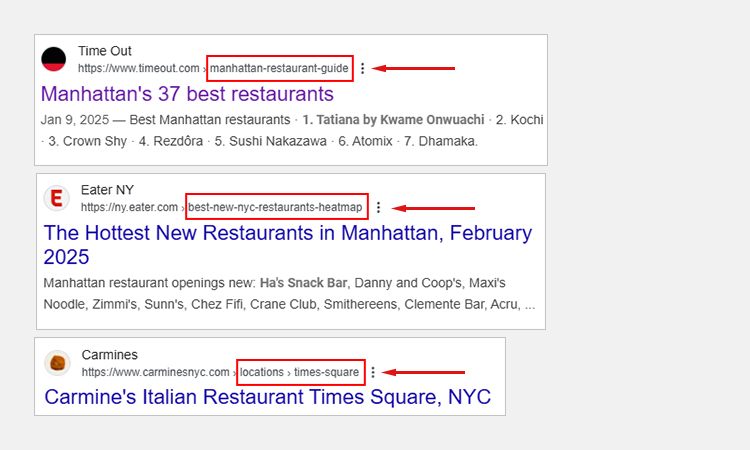
Web content retrieval becomes more precise with the implementation of Schema markup which is an HTML code type for search engines to better understand website pages.
Restaurants benefit from schema markup which emphasizes crucial information about their menu while showing their hours and location and gathering customer reviews.
When you add schema markup to your restaurant listing it improves your search engine placement as enhanced results or rich snippets promote higher click through rates.
By adding schema markup for your restaurant, you increase the chances of appearing in rich snippets.
You can reach other enhanced results on search engines, which can help attract more clicks.
Technical SEO for Restaurants
Technical SEO refers to the process of optimizing a website’s technical aspects to improve its search engine rankings. Here are some technical SEO tips for restaurants:
- Optimize your website’s structure: Make sure your website’s structure is easy to navigate and optimized for search engines. Use header tags, meta descriptions, and optimized images to improve your website’s structure.
- Use schema markup: Schema markup helps search engines understand your website’s content and structure. Use schema markup to highlight your restaurant’s menu, services, and online ordering options.
- Improve page speed: Page speed is essential for user experience and search engine rankings. Make sure your website loads quickly and is optimized for mobile devices.
- Use SSL encryption: SSL encryption helps secure your website and protect customer data. Make sure your website has an SSL certificate to improve trust and security.
Content Marketing for Restaurants
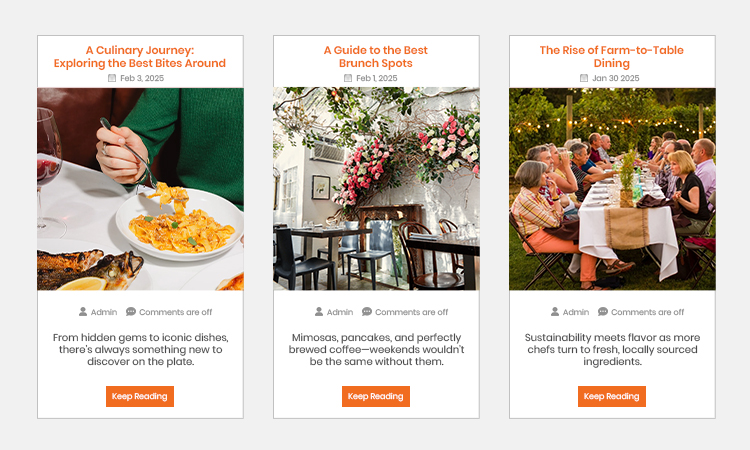
Your SEO performance will benefit from content marketing as a vital strategy.
Your website authority and search result relevance will increase when you maintain routine posting of high-quality restaurant-related content.
Here are some content marketing ideas for restaurants:
- Blog Posts: Your content should contain food-related material that suits your audience while featuring recipes alongside culinary tips and sidelights from your restaurant establishment.
- Social Media Posts: Post gorgeous visuals of your culinary dishes and promotional activities and important events across your social media feeds. Your SEO benefits from social signals that include platform user interaction metrics and content-sharing activities.
- Videos: Your restaurant’s short videos should demonstrate its atmosphere followed by feature presentations on fan events along with interviews of your culinary team. Google search pairs successfully with video content alongside social platforms for visibility.
Online Ordering and Delivery Optimization
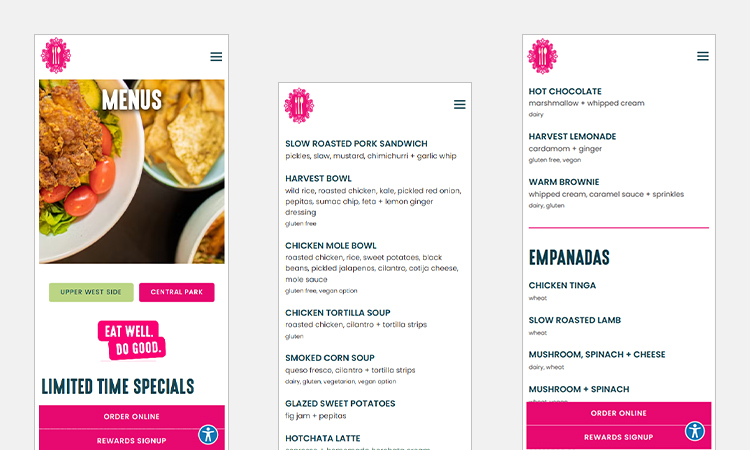
Online ordering and delivery are becoming increasingly popular for restaurants. Here are some tips to optimize your online ordering and delivery options:
- Integrate online ordering with your website: Make sure your website has a seamless online ordering experience. Integrate your online ordering platform with your website to improve user experience and increase conversions.
- Optimize your menu for online ordering: Make sure your menu is easy to navigate and optimized for online ordering. Use high-quality images, detailed descriptions, and clear pricing to improve user experience.
- Use delivery integrations: Use delivery integrations like UberEats, GrubHub, and DoorDash to expand your delivery options and reach new customers.
- Improve your online ordering process: Make sure your online ordering process is easy to use and optimized for conversions. Use clear calls-to-action, simple checkout processes, and personalized recommendations to improve user experience.
Tracking and Analytics
After executing your search engine optimization strategies you must monitor how well they are working.
Use tools like Google Analytics and Google Search Console to monitor key metrics such as:
- Organic Traffic: Your website tracking system needs to record the number of visitors who discover your site through search engine results.
- Keyword Rankings: Keep the ranking keywords your website achieves and adapt your strategy accordingly.
- Conversion Rate: You must track visitor engagement rates related to desired conversion activities such as reservations or online orders.
Your ongoing SEO performance assessment will help you improve your SEO strategy.
This way you can achieve better outcomes.
Why Google Business Profile is Crucial for Restaurants
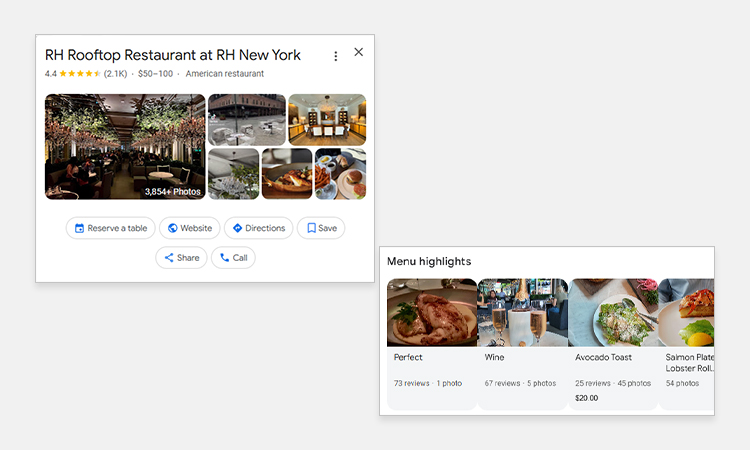
Local SEO for restaurants depends significantly on the powerful tool known as Google My Business (GMB).
Using this free platform businesses can regulate their Google profile visibility through both search engine and map services.
Your restaurant gains visibility on local search results when you optimize your GMB profile correctly.
How to Optimize Your GMB Listing:
- Accurate Business Information: Ensure every detail including your physical address and phone number together with your operating hours matches perfectly.
- Categories: Your restaurant must pick the categories which best describe your business among options such as “Italian Restaurant” or “Vegetarian Friendly.”
- Photos: Insert into your profile superior images that showcase your restaurant establishment along with the food selection and decorating style. Potential customers will be attracted to your listing because visual elements make it more compelling.
- Posts: Features allow you to post detailed updates about promotions along with listings of upcoming restaurant events. By using this feature you can keep your Google My Business profile interesting and current.
Website Speed: The Silent SEO Factor
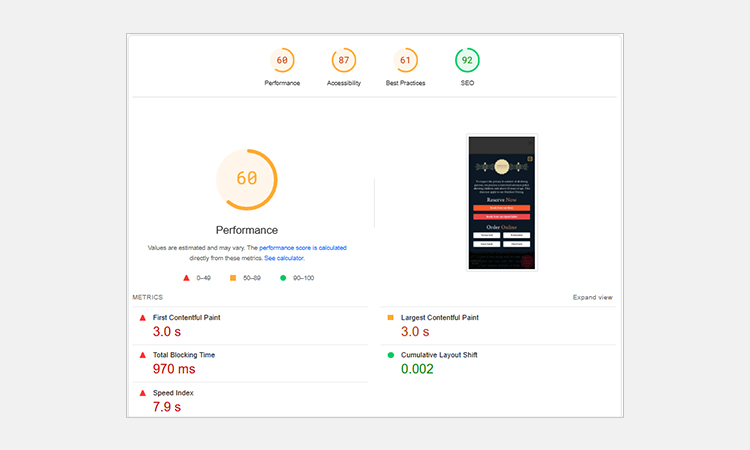
Local SEO for restaurants depends significantly on the powerful tool known as Google My Business (GMB).
Using this free platform businesses can regulate their Google profile visibility through both search engine and map services.
Your restaurant gains visibility on local search results when you optimize your GMB profile correctly.
Tips for Improving Website Speed:
- Optimize Images: Large image files can slow down your site. Compress images without sacrificing quality.
- Minimize Code: Clean up unnecessary HTML, CSS, and JavaScript to ensure your site loads quickly.
- Use a CDN: A Content Delivery Network (CDN) distributes your website’s content across multiple servers, speeding up load times for users worldwide.
The Power of Online Reviews
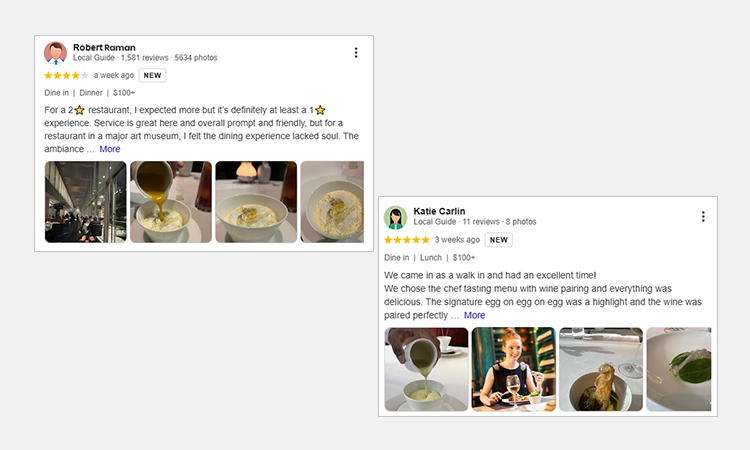
The significance of customer reviews enhances both your restaurant brand perception and your Search Engine Optimization rankings.
Positive evaluations through Google and Yelp alongside TripAdvisor create two benefits: they establish trust for business prospects and improve website ranking position.
Why Reviews Matter:
- Trust: Any restaurant with positive online reviews earns more customer trust because of it. Positive feedback from satisfied customers drives decision making among prospective diners.
- SEO Benefits: The number of reviews you accumulate will impact your restaurant’s Google ranking because Google places reviews as a core component for defining search positions.
- Engagement: When restaurateurs choose to respond to reviews the result is a double win: customers understand managers value feedback so they feel motivated to submit more evaluations.
Continue encouraging your satisfied customers to review your business as you avoid pushing them.
Every restaurant can gain more reviews by sending a follow-up email after meals containing a Google review link.
Social Media and SEO: A Symbiotic Relationship
Social media activities do not influence your website’s SEO position yet they act powerfully to send people to your website while advancing your restaurant’s digital footprint.
Your website’s traffic volume typically improves your search engine rankings as time passes.
How Social Media Helps SEO
- Traffic Generation: Your website ratings improve when you distribute links to both website content and blog entries since it informs Google your platform holds value.
- Engagement: The activity on your social profiles informs Google that your restaurant remains vibrant and celebrated therefore indirectly supporting SEO efforts.
- Brand Awareness: Platforms where users frequently mention or share your restaurant will raise the likelihood of obtaining backlinks to your website which improves your SEO ranking.
How to Build Quality Backlinks for SEO
SEO depends heavily on backlinks because other websites linking to your restaurant mean better search engine rankings.
Google interprets backlinks as formal site endorsements and you will gain improved site rankings through high-quality backlinks.
Ways to Build Backlinks:
- Partner with Local Influencers: Contact local food bloggers and critics to review your restaurant while offering them website link opportunities.
- Collaborate with Local Businesses: Partner with nearby businesses to cross-promote each other and exchange backlinks.
- Create Shareable Content: Create link-worthy content through items like infographics and local food guides which people will want to share.
Importance of Having a Mobile-Optimized Menu
As smartphones continue to dominate, many customers will search for your menu while they’re on the go.
Having a mobile-friendly menu is a must.
A clunky, hard-to-read menu can turn potential customers away before they even get to your food offerings.
Tips for a Mobile-Friendly Menu:
- Keep it Simple: Ensure that your menu is easy to navigate, with clear section headings and concise descriptions.
- Keep it Simple: Ensure that your menu is easy to navigate, with clear section headings and concise descriptions.
- Make it Searchable: If your menu is on your website, make sure it can be easily found with a quick search.
- Include Pricing: Clearly list prices so customers don’t have to dig around to find them.
Leveraging Online Reservations for SEO
Many restaurants now offer online reservations through platforms like OpenTable or Resy.
While these platforms help customers book tables easily, they can also have an impact on your SEO.
How Online Reservations Affect SEO:
- Local SEO Boost: Online reservations can help your restaurant appear in local search results when people search for “restaurants with reservations near me.”
- Customer Engagement: Customers who make reservations online may leave reviews afterward, contributing to your restaurant’s online reputation.
Keep Your Information Up-to-Date
Outdated information can frustrate customers and harm your SEO.
For example, if your hours are incorrect or your menu items are no longer available, potential diners may leave your site and look elsewhere.
Google’s crawlers rely on consistent, accurate information across all platforms.
What to Update Regularly:
- Business Hours: Ensure your operating hours reflect holidays or seasonal changes.
- Menu: If you’ve changed or updated your menu, make sure the online version reflects this.
- Special Offers: If you’re running promotions, make sure they’re listed clearly on your site and Google My Business profile.
Common SEO Mistakes to Avoid
While working on your SEO, here are a few common mistakes to avoid:
- Ignoring Local SEO: Paying no attention to local SEO represents a significant error in restaurant marketing since searchers mostly look for businesses in their immediate area.
- Not Optimizing for Mobile: Mobilizing your website remains a fundamental requirement because any lack of mobile optimization will cripple your potential customer base.
- Neglecting Reviews: Your SEO performance and reputation benefit strongly from positive customer reviews which you should prioritize.
- Keyword Stuffing: The use of excessive keywords in your content material reduces your search engine rankings. Always aim for natural readability.
Conclusion
SEO is a powerful tool for getting your restaurant noticed by potential customers online.
By focusing on local SEO, optimizing your website, creating valuable content, and regularly tracking your progress, you can enhance your visibility in search engines and attract more diners.
Additional Resources:
- A Handbook for Social Media Marketing for Restaurants
- Get It Right Guide to Local SEO for Restaurants


